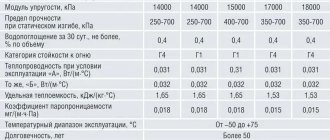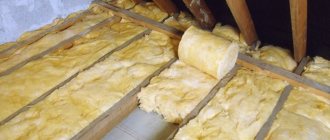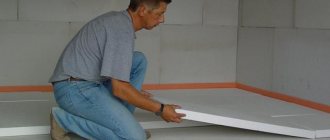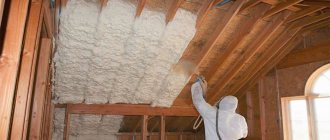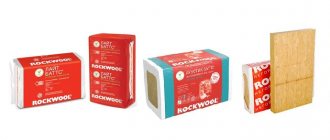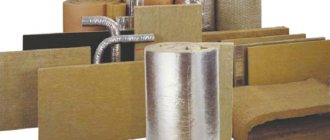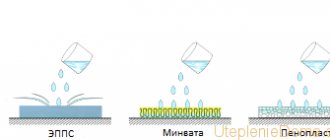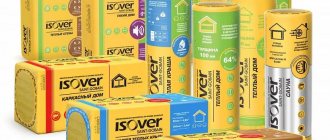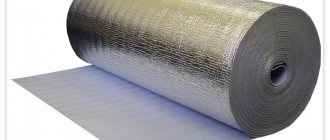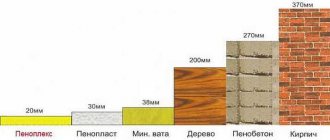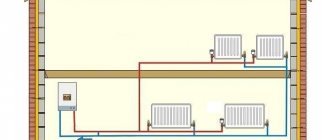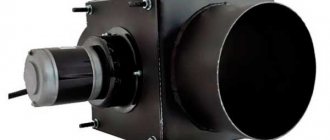List of insulation characteristics
- Thermal conductivity coefficient - , W/(m•K) The main characteristic of any insulation. The lower this number, the less energy the insulation transmits through itself and the better its thermal insulation. The less insulation layer will be needed. For most insulation materials it is in the range = 0.025 - 0.18 W/(m•K). As you can see, the spread is very large - 10 times. This means that the insulation materials themselves are very diverse.
- Volumetric weight - kg/m3. An important indicator when determining the load of structures. It can vary within very large ranges of 20 - 300 kg/m3. Insulation materials sometimes include foam concrete and expanded clay, with a volumetric weight of 600 kg/m3.
- Flammability - you can focus on the descriptive characteristic Flammability class - determined by the assigned index G1-G4.
- Water absorption is determined as a percentage of the mass or volume of dry insulation. An important indicator, since water absorption significantly reduces the thermal insulation properties of the insulation itself.
- Sorptive humidity determines the ability to absorb moisture from the air. An important indicator that determines how much the characteristics can change when air is humidified.
- Vapor barrier properties are also an important indicator. Hydro-steam insulators retain moisture in the room, but, at the same time, can isolate the room from the source of humidity.
- Sound insulation - often given in a descriptive form - a good sound insulator or a mediocre one.
- Environmental friendliness is a conditional indicator; a description of possible environmental threats is usually given.
- Durability, - years. For many insulation materials, the durability has not been precisely established, since their use period has not expired.
- Air permeability plays a role only for cotton wool and bulk insulation. Convection heat leaks directly depend on it when air moves through the insulation. Cotton insulation with high air permeability (density up to 80 kg/m3) requires the use of a windproof membrane under the ventilation gap.
Other characteristics may be used to describe insulation materials, depending on the physical characteristics of the material itself. Let's take a closer look at the characteristics of the most popular insulation materials, as well as the features of their application.
Arbolit
This building material is made from wood shavings and sawdust, chopped reeds and chopped straw. The base is a cement base and some chemical additives. At the last stage of wood concrete production, the semi-finished insulator is treated with a mineralizer.
It has the following characteristics: density up to 700 kg/m3 and thermal conductivity up to 0.12 W*m/K. Since up to 90% of the composition is wood waste, wood concrete is extremely sensitive to high humidity, so it must be used in conjunction with good waterproofing agents.
Wood concrete is sold in the form of blocks, the thickness of which reaches 20 cm. This insulation is quite easy to make with your own hands.
Styrofoam
- Thermal conductivity coefficient = 0.036 - 0.04 W/(m•K).
- Density - 15 - 35 kg/m3.
- Water absorption is low, 1% wt.
- Vapor permeability coefficient - 0.05 mg/(mchPa).
- Ultimate compressive strength - 0.07 - 0.23 MPa.
- Sorption humidity - 1.0% wt.
- Flammability – with fire retardant additives, it maintains combustion for no more than 3 seconds and releases deadly poisons.
- Sound insulation is mediocre.
- Environmental friendliness is in doubt.
- Durability - 5 - 15 years.
- Price - low
Polystyrene foam is the cheapest and most popular material for insulating houses and apartments. Most often, external walls are insulated with polystyrene foam using wet facade technology. But it can also be used in a variety of other places, for example, for roof insulation. It cannot be in direct contact with water, as it gradually absorbs it and loses its properties. It is always preferable to use denser versions of foam plastic 25 -35 kg/m3, as they are more durable and more resistant to external influences.
Extruded polystyrene foam
- Thermal conductivity coefficient = 0.03 - 0.035 W/(m•K).
- Density - 35 - 52 kg/m3.
- Water absorption is the lowest, no more than 0.4% of the volume.
- Ultimate compressive strength - 0.15 - 0.20 or more MPa.
- Sorption humidity - 0.1 - 0.3% wt.
- Flammability - burns only when exposed to flame, releases deadly poisons.
- Vapor permeability coefficient - 0.005 mg/(mchPa).
- Sound insulation is average.
- Environmental friendliness is questionable, satisfactory.
- Durability - 15 - 35 years.
- The price is average.
Minimal water absorption and vapor permeability makes it possible to use the material in contact with water and soil, without changing its properties over time. Also, extruded polystyrene foam has increased areal compressive strength. This makes it possible to use it directly under screeds and other coverings, and denser versions also where a car may be hit. It is used under screeds, in underfloor heating systems, for insulating foundations, pipelines, cellars, and roofs.
PPU
Polyurethane foams are based on polyester with the addition of emulsifiers, disocyanate and water. Under the influence of catalysts, the chemical reaction of the starting components produces a new substance called polyurethane foam (PUF). The advantages of polyurethane foam include high noise absorption, chemical passivity, and moisture resistance.
PPU refers to thermal insulation that is sprayed onto the surface: this way it covers even complex and hard-to-reach areas of ceilings and walls. The density of polyurethane foam reaches 80 kg/m3, the thermal conductivity coefficient is one of the lowest among various TIMs - 0.028 W*m/K.
Fibrolite
Wood wool refers to small, narrow pieces of wood shavings. It is wood wool that is the basis for fiberboard.
This insulator is produced in the form of slabs and is not afraid of exposure to the external environment.
Thanks to special impregnations, fiberboard has unusually high moisture resistance and can be used in rooms with consistently high humidity - for example, in swimming pools.
The density of this material ranges from 300 to 500 kg/m3, and thermal conductivity reaches a value of 0.1 W/m per Kelvin.
Ceramic wool
Aluminum, silicon or zirconium oxide gave the consumer an excellent thermal insulation material called ceramic wool. It is produced using a centrifuge. At high speeds, the starting materials are inflated, which, after cooling, are shaped into rolls.
Review of manufacturers, or what does the Russian market offer?
Let's look at which manufacturers today supply stone wool to the domestic market of insulating materials:
Knauf: recognized world leader
The most famous manufacturer of stone wool in the whole world is the German concern Knauf. He began producing products in 1932, and in the field of thermal insulation he mainly specializes in basalt fiber, although he sometimes produces fiberglass materials.
Knauf has a fairly well thought out choice of insulation for different house structures, for which they produce as many as five series for roofs, walls, ceilings and partitions. Knauf also has universal mineral wool, which is suitable for any task:
Today Knauf produces stone wool literally for the whole world. But, unfortunately, buyers often complain about the increased rigidity of the slabs, which prick.
Of course, it’s not like glass wool; it’s more likely that there’s just an unpleasant sensation when working with bare hands. On the other hand, no one abroad would even think of working with cotton insulation without gloves.
Rockwool: high quality
No less famous is Rockwool - a Danish company that has been operating since 1909. All its factories use only European equipment, which the company is especially proud of. Stone wool is supplied in the following forms:
By the way, Rockwool also has factories in Russia. Among other advantages of this basalt insulation, users usually note that it does not crumble or shrink, and also pleases with a wide selection of sizes and packaging. Those. It’s quite easy to choose the right option for building your favorite home.
Ursa: expensive equipment
But Ursa have developed a new line of mineral wools. In fact, these are three entire production sites operating as the Ursa Eurasia association. Their main trump card is high-tech equipment. Previously, they worked more with fiberglass boards, but today they use more natural basalt raw materials with acrylic-containing components.
Urs also has factories in Russia, namely in the city of Chudnovo. According to the manufacturer, new high-tech equipment from Europe was also imported there, and therefore you don’t have to worry about quality.
And Russia especially liked the Pureone series. By the way, this manufacturer’s basalt insulation is considered one of the best in terms of sound and heat insulation, although it has insufficient vapor permeability, as some complain.
TechnoNIKOL: for special loads
TechnoNIKOL is one of the most famous manufacturers of basalt insulation in Russia, producing its products under the Rocklight brand:
What’s interesting is that each TechnoNIKOL enterprise has its own laboratory. Thanks to this, multi-stage control is constantly carried out over the products. As a result, TechnoNIKOL received a European level certificate for its products.
And at one time, TechnoNIKOL modernized its production lines and was able to achieve a rather unique property of mineral wool - increased rigidity, thanks to which each basalt tile can withstand a load of up to 7 tons. The manufacturer is also trying to make the insulation unattractive to small rodents, but they love such materials so much.
Statistics
Many people believe that it is enough to buy insulation and install it on the wall and it will function normally. You need to select the right material and, most importantly, it should be enough. The thickness of different insulation materials varies greatly, so you need to familiarize yourself in advance with the thermal conductivity of which material you will be working with.
Not everyone will want to shell out large sums of money for insulation for a wall made of aerated concrete, which suddenly won’t work. Much depends on the thickness of the wall and the insulation itself; 10 cm will be enough for the use of wool to be correct. Which cotton wool is best for insulation? To begin with, it is worth comparing the characteristics of different types of thermal insulation.
Additional properties of thermal insulation materials:
Density. The ratio of mass to volume occupied by a material.
Moisture absorption. Determines the amount of moisture contained in the insulator
It is important to consider the total moisture content of the material at various temperature changes, relative to the importance in the air. Hydrophobization significantly reduces the properties of mineral wool to absorb moisture
For this purpose, special additives are specially introduced that protect the material from water.
Biosecurity. The ability to counteract the dominance of microorganisms, as well as the development of fungal formations and some types of insects. For the most part, all living creatures are attracted to dampness, so the moisture-protective properties closely interact with thermal insulation.
Fire resistance. Structures can withstand high temperatures for a long period without collapsing.
Fire safety.
Strength. If the strength is high, then the material is used to insulate load-bearing fencing structures. There is also a separate parameter - bending strength. This applies to those insulation materials that are installed on pipelines and other similar objects. Tensile strength is necessary in order to determine the possible level of safety during storage, transportation and installation.
Endurance. A material can lose all its properties and features when the temperature increases or decreases.
Heat capacity. In conditions of frequent thermal changes, this characteristic is extremely important.
Frost resistance. The ability of the material to withstand repeated temperature changes at any stage of freezing. Relevant in winter with severe frosts. The main thing is that no visible signs of destruction of the insulation structure are noticed.
Insulation for the walls of a house is not the only function that can be limited. The home owner should give preference to external insulation, as well as thermal insulation of pipelines.
from different sides of the house with equal efficiency.
Thermal insulation properties can be leveled due to a number of mistakes. For example, inappropriate fasteners. When insulating with foam plastic, dowels and cheap, low-quality glue are used.
We advise you to study - Slate sheet sizes
If you have forgotten the parameters of moisture resistance, density or other insulation characteristics, then it is worth looking at the ratings of various thermal insulators. The table will help you quickly navigate and find the best material based on one of its properties.
The basement deserves just as much attention as the rest of the house.
It takes an important part in the heat losses of the building, its role is key. Especially when it comes to facade insulation
This instructional text will help home owners who decide to install thermal insulation themselves, without the help of specialists. Let's start with filling, the technology of which turned out to be unsophisticated and simple.
- We drill holes on the outside wall in a staggered pattern.
- We stretch the tubes from the special installation and insert them into these holes.
- After this, we supply the foam material.
The whole process happens so quickly. That two people are enough to insulate three floors of a cottage. Insulating the outside with slabs will be much more expensive than the above insulation option. The price of many companies increases with each centimeter of cavity width.
Roll Size Chart
For comparison, we take insulation whose thickness does not exceed 50 mm. This is due to the fact that more massive rolled thermal insulation materials roll up much worse. The review involves fiber coatings. Manufacturers of insulation in rolls:
Material gradeWidth, mmLength, mm
| Ursa M-11 | 1200 | The manufacturer offers two options: 7000 and 9000 |
| Heat Knauf Dacha | 1220 | 7380 |
| Isover Classic | 1220 | 8200 |
| Isover Sauna | 1220 | 12500 |
To compare coatings by cost and determine the most suitable option, take into account the number of strips in the package.
Reflective type thermal insulation
Insulation materials, called reflective or reflective, work on the principle of slowing down the movement of heat. After all, every building material is capable of absorbing this heat and then radiating it. As is known, heat loss occurs mainly due to the exit of infrared rays from the building. They easily penetrate even materials with low thermal conductivity.
But there are other substances - their surface is capable of reflecting from 97 to 99 percent of the heat reaching it. These are, for example, silver, gold and polished aluminum without impurities. By taking one of these materials and constructing a thermal barrier using polyethylene film, you can get an excellent thermal insulator. Moreover, it will also serve as a vapor barrier. Therefore, it is ideal for insulating a bathhouse or sauna.
Today's reflective insulation is polished aluminum (one or two layers) plus polyethylene foam (one layer). This material is thin, but gives a tangible result. So, with a thickness of such insulation from 1 to 2.5 centimeters, the effect will be the same as when using a fibrous heat insulator from 10 to 27 centimeters thick. As an example, let's name Armofol, Ecofol, Porilex, Penofol.
One of the types of reflective thermal insulation.
Introduction
Thermal insulation plays an important role in modern industry.
With its help, issues of life support, organization of technological processes, and energy saving are solved. Thermal insulation structures are an integral part of the protective elements of industrial equipment, pipelines, and parts of industrial buildings. Thanks to insulation, the reliability, durability and operational efficiency of buildings, structures and equipment are significantly increased. Thermal insulation performs the following functions:
- reduces heat losses to the environment from objects (buildings, structures, equipment, pipelines, etc.);
- ensures normal technological process in devices;
- maintains the specified temperatures of components in technological processes;
- creates normal temperature conditions for service personnel;
- reduces temperature stress in metal structures, refractory lining, etc.;
If insulation is performed to prevent heat loss from the insulated surface to the environment, it is called thermal.
Due to the widespread development in industry of technological processes occurring under conditions of high temperatures and pressures, the role and importance of thermal insulation is continuously increasing.
Thermal insulation work is the final stage in the process of constructing objects, and therefore, not only the timing of commissioning of these objects, but also the quality of the products, the economic and technical characteristics of the objects, and comfort in the workplace depend on their quick and high-quality implementation.
Both abroad and in our country, the development of the production of thermal insulation works follows the path of industrialization with the use of modern thermal insulation materials and structures, highly mechanized tools and devices, as well as prefabricated scaffolding facilities (scaffolding, scaffolding). In the practice of thermal insulation work, fully prefabricated structures are increasingly used, supplied from enterprises in the form of ready-made complex elements consisting of thermal insulation and cover layers, equipped with a set of fasteners. The production of thermal insulation work in this case comes down to the installation of ready-made elements on the insulated one.
